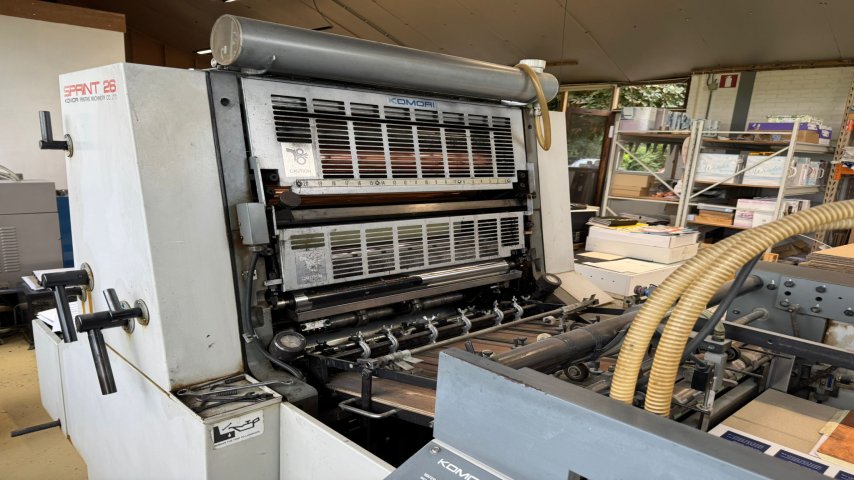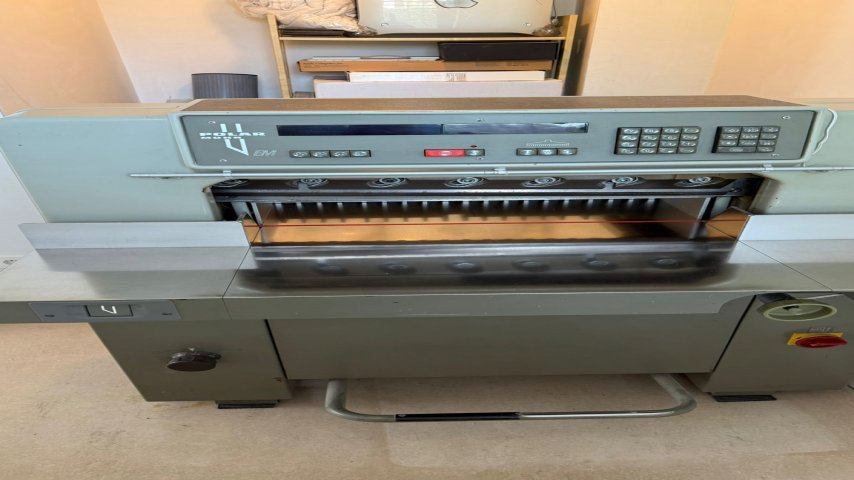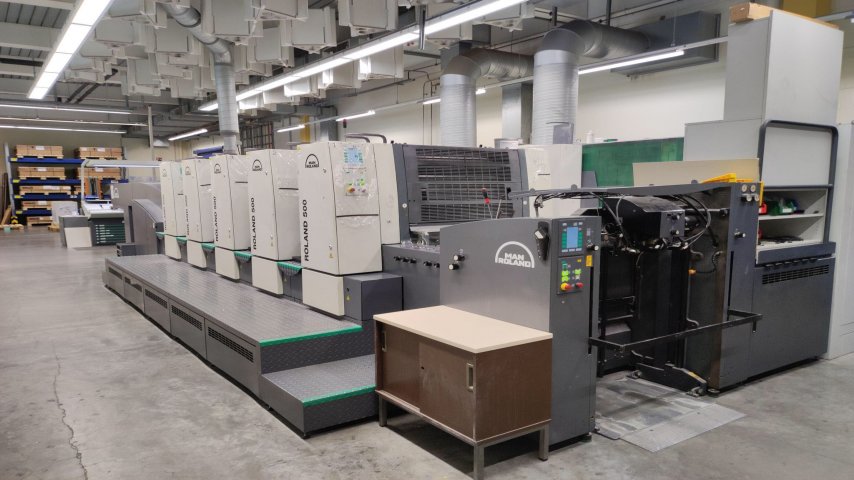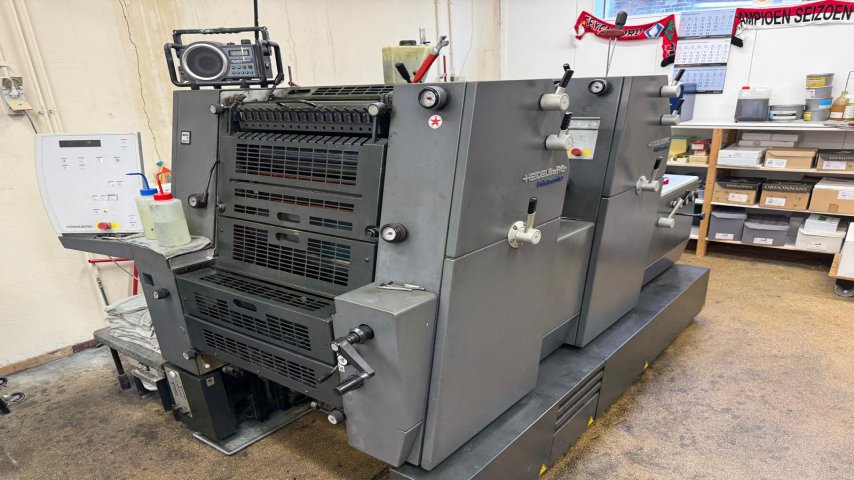- Home
-
Machinery List
Machinery List (148) Stocklist (144) Sheet Offset (23) Converting (109)All Guillotine (16)Folding Machine (18)Perfect Binding (6)Saddle Stitching (4)Gathering (4)Miscellaneous (60)Cross Feeder (1)Web Offset (1) Paper Converting (4) Solid Board Converting (2) Corrugated Board Conv. (2) Preamplifiers (4) Accessory (3)
- Sell machine
- Service
- Contact
Nipping and Pressing station
Date: 2021-06-23

What is the Nipping and Pressing Station?
The nipping and pressing station is a critical part of the finishing process in print production, particularly in binding operations. Its primary purpose is to apply pressure to the spine of a gathered set of pages (such as a book, catalog, or brochure) to ensure that they are securely bound. This stage involves both the mechanical nipping, which aligns and holds the pages in place, and the pressing process, which applies even pressure across the spine to ensure proper adhesion and alignment.
The nipping and pressing process is typically followed by additional finishing steps such as trimming, folding, or gluing, depending on the type of product being produced. The importance of this station lies in its ability to create a clean, well-bound final product that is not only visually appealing but also durable enough to withstand frequent handling.
Why is the Nipping and Pressing Station Important?
1. Ensuring Binding Strength and Durability
One of the primary functions of the nipping and pressing station is to ensure that the binding of the printed pages is strong and durable. Without proper nipping and pressing, the pages could become loose, misaligned, or fail to stay in place over time, which would significantly reduce the lifespan and quality of the final product. This is particularly important for high-volume, high-quality publications such as books, catalogs, and magazines, where the binding must withstand repeated opening and closing.
The process of applying even pressure to the spine of the gathered pages ensures that they are securely held together. The nipping mechanism aligns the pages properly, while the pressing process ensures that the adhesive or binding material adheres evenly to all areas, providing a strong and durable bond.
2. Precision and Alignment
The nipping and pressing station is also crucial for ensuring that the printed pages are properly aligned. Misalignment during the binding process can lead to crooked or unevenly bound products, which can affect the final appearance and usability of the material. The nipping function precisely aligns the pages before pressure is applied, preventing such issues from occurring.
By holding the pages securely in place during the pressing stage, the station ensures that the spine of the publication is even and that the pages are uniformly adhered to the binding material. This level of precision is especially important in high-end printing jobs where the visual appeal and professionalism of the final product are paramount.
3. Even Pressure Distribution
In the nipping and pressing station, even pressure distribution is key to ensuring a consistent and high-quality final product. If pressure is applied unevenly, certain areas of the spine may be over-compressed, leading to weak spots in the binding. Similarly, if the pressure is too light, the pages may not adhere properly, resulting in a binding that is prone to failure.
The pressing function is designed to apply uniform pressure across the entire length of the spine, ensuring that all pages are securely bound without any weak spots. This even distribution of pressure helps improve the overall quality of the product, preventing issues such as page separation, loose bindings, or uneven edges.
4. Improved Efficiency and Speed
The automation of the nipping and pressing station enhances the speed and efficiency of the binding process. As part of a fully integrated print finishing system, the nipping and pressing station can be automated to quickly handle large volumes of material, reducing the need for manual intervention and improving production speed.
In addition to speed, automation also ensures consistency. By removing human error from the equation, the nipping and pressing station can maintain a high level of accuracy throughout the print run, ensuring that every piece produced meets the desired quality standards.
5. Aesthetic and Structural Quality
The nipping and pressing process also contributes to the aesthetic quality of the finished product. By ensuring a strong, even bond, this station helps create a clean and professional appearance for bound materials. The spine of the book or publication will appear neat, with no signs of uneven binding, glue seepage, or page misalignment.
From a structural standpoint, the nipping and pressing station plays a crucial role in ensuring that the final product is sturdy enough to withstand repeated handling. Whether the end product is a hardcover book, a catalog, or a brochure, the nipping and pressing station ensures that the binding is not only functional but also aesthetically pleasing, contributing to the overall quality of the print piece.
Key Benefits of the Nipping and Pressing Station
Stronger Bindings: Provides durable, long-lasting bonds, ensuring that pages stay securely in place over time.
Higher Precision: Ensures pages are perfectly aligned and evenly pressed, preventing misalignment and uneven edges.
Enhanced Aesthetic Quality: Guarantees a neat, professional finish with no signs of binding issues such as crooked spines or misaligned pages.
Increased Production Efficiency: Reduces manual labor and speeds up the binding process, improving throughput and consistency.
Improved Structural Integrity: Helps the product withstand frequent handling and prevents damage to the binding over time.
Conclusion
The nipping and pressing station is an essential part of the finishing process in print production. By providing precise alignment, even pressure, and strong binding, it ensures that printed materials are durable, aesthetically pleasing, and of high-quality. From high-end books to catalogs and brochures, the nipping and pressing station contributes significantly to the overall success of the printing process, ensuring that every product meets the highest standards of performance and presentation.
As print technology continues to evolve, the importance of automated, efficient, and reliable nipping and pressing systems will only increase, allowing print businesses to deliver top-quality products faster and more efficiently than ever before.
Author: Ahmet Karakus
Tags: Bogenoffset; Digitaldruck; Papierbeutelmaschine; Papierverarbeitung; Rollenoffset; Vollpappe Verarbeitung; Vorstufengeräte; Weiterverarbeitung; Wellpappe Verarbeitung; Zubehör; 1 Farben; 2 Farben; 4 Farben; 5 Farben; 6 Farben; 7 Farben; 8 Farben; 3 Farben; 10 Farben; Verschiedene; Flach&Seitenfaltenbeutel; Klotzbodenbeutel; Kreuzbodenbeutel; Zweinahtbeutel; Druckwerke; Verschiedene; Prägemaschine; Stanztiegel; Stanzzylinder; Querschneider; Rollenschneider; Verschiedene; Zeitungdruck; Akzidenzdruck; Endlosdruck; Etikettendruck; Flexodruck; Tiefdruck; Verschiedene; Etikettenstanzen; Faltschachtelklebe; Autoplatine; Stanztiegel; Fenstereinklebe; Schachtelueberzieh; Verschiedene; CTP-Anlage; Filmbelichter; Plattentwicklungsmaschine; Filmentwickler; Kopiermaschine; Plattenkopierer; Verschiedene; Schneidemachine; Falzmachine; Klebebinder; Sammelhefter; Dreischneider; Zusammentrag; Fadenheft; Buchdeckmaschine; Buchfertigungsstrassen; Verschiedene; Drahtheftmaschinen; Einsteckmaschinen; Kreuzleger; Casemaker; Druckslotter; Hefter & Kleber; Laminiermaschine; Autoplatine; Stanztiegel; Verschiedene; Diverse Geräte; Walzen; Nummerierer werke; Sheet Offset; Digital Print; Paper Bag Making; Paper Converting; Web Offset; Solid Board Converting; Prepress Equipment; Converting; Corrugated Board Conv.; Accessory; 1 Color; 2 Colors; 4 Colors; 5 Colors; 6 Colors; 7 Colors; 8 Colors; 3 Colors; 10 Colors; Miscellaneous; Flat & Satchel; Block Bottom; Cross Bottom; Twin Seam; Print Units; Miscellaneous; Foil Stamping; Handplaten; Punching cylinders; Sheeter; Slitter Rewinder; Miscellaneous; Newspaper; Commercial; Business Form; Label machine; Flexo machine; Gravure; Miscellaneous; Label Punching; Folder Gluer; Autoplaten; Handplaten; Window Patcher; Box Coverer; Miscellaneous; CTP; Film Exposure; Plate developer; Film developer; Copy Box; Plate Copy; Miscellaneous; Guillotine; Folding Machine; Perfect Binding; Saddle Stitching; Three Knife Trimmer; Gathering; Sewing; Block Processing; Book production lines; Miscellaneous; Stitching Machine; Inserting Machines; Cross Feeder; Casemaker; Print Slotter; Gluer & Slitcher; Laminator; Autoplaten; Handplaten; Miscellaneous; Other Device; Roller; Numbering device; Baski Ofset; Dijital Baski; Kagit Torba Makinesi; Kagit Isleme; Rulo Ofset; Kati Karton Isleme; Ön Hazirlik Cihazlari; Ileri Isleme; Dalgali Karton Isleme; Aksesuar; 1 Renk; 2 Renk; 4 Renk; 5 Renk; 6 Renk; 7 Renk; 8 Renk; 3 Renk; 10 Renk; Çesitli; Düz ve Çanta Tipi; Kare Taban Çanta; Çapraz Taban Çanta; Ikili Dikisli Çanta; Baski Ünitesi; Çesitli; Yaldiz Baski; Elle Basma Makinesi; Döner Silindiri; Kesici; Rulo Kesici; Çesitli; Gazete Baskisi; Ticari Baski; Sürekli Form Baski; Etiket Baskisi; Flexo Baski Makinesi; Derinlik Baskisi; Çesitli; Etiket Düzlemesi; Kutu Yapistirma; Otomatik Platen; Elle Basma; Pencere Kapama; Kutu Kapatma; Çesitli; CTP; Film Pozlama; Plaka Gelistirici; Film Gelistirici; Kopya Makinesi; Plaka Kopyalama; Çesitli; Kesme Makinesi; Katlama Makinesi; Mükemmel Ciltleme; Zimbalama; Üçlü Kesici; Toplama; Dikisli Ciltleme; Blok Isleme; Kitap Üretim Hatlari; Çesitli; Dikis Makinesi; Yerlestirme Makinesi; Çapraz Besleyici; Kitap Kapatma Makinesi; Baski Slotteri; Yapitirici & Zimba; Laminatör; Otomatik Platen; Elle Basma; Çesitli; Diser Cihazlar; Rulo; Numaralandirci Cihaz; Impression feuille à feuille; Impression numérique; Machine à fabriquer des sacs en papier; Traitement du papier; Impression offset en bobine; Transformation de carton plein; Équipements de prépresse; Transformation; Transformation de carton ondulé; Accessoire; 1 Couleur; 2 Couleurs; 4 Couleurs; 5 Couleurs; 6 Couleurs; 7 Couleurs; 8 Couleurs; 3 Couleurs; 10 Couleurs; Divers; Type Plat et Sac; Sac de Fond Carré; Sac de Fond Croisé; Sac à Double Couture; Unité d'Impression; Divers; Impression Dorée; Machine de Stamping Manuel; Cylindre Rotatif; Coupeuse; Coupeuse de Rouleaux; Divers; Impression de Journal; Impression Commerciale; Impression de Formulaires Continus; Impression d'Étiquettes; Machine Flexo; Impression en Profondeur; Divers; Mise en Forme des Étiquettes; Collage de Boîtes; Platen Automatique; Estampage Manuel; Fermeture de Fenêtres; Fermeture de Boîtes; Divers; CTP; Exposition de Film; Développeur de Plaques; Développeur de Film; Machine de Copie; Copie de Plaques; Divers; Machine de Coupe; Machine de Pliage; Reliure Parfaite; Agrafeuse; Coupeuse Triple; Rassembleuse; Reliure Cousue; Traitement de Blocs; Lignes de Production de Livres; Divers; Machine à Coudre; Machine de Placement; Alimentation Croisée; Machine de Fermeture de Livres; Slotter d'Impression; Colle & Agrafe; Laminateur; Platen Automatique; Estampage Manuel; Divers; Autres Équipements; Rouleau; Compteur de Nombres; Impresión offset de hojas; Impresión digital; Máquina para hacer bolsas de papel; Procesamiento de papel; Impresión offset de rollo; Procesamiento de cartón sólido; Equipos de preimpresión; Conversión; Procesamiento de cartón corrugado; Accesorio; 1 Color; 2 Colores; 4 Colores; 5 Colores; 6 Colores; 7 Colores; 8 Colores; 3 Colores; 10 Colores; Varios; Tipo Plano y de Bolsa; Bolsa de Fondo Cuadrado; Bolsa de Fondo Cruzado; Bolsa de Doble Costura; Unidad de Impresión; Varios; Estampado en Oro; Máquina de Estampado Manual; Rodillo Rotativo; Cortadora; Cortadora de Rodillo; Varios; Impresión de Periódico; Impresión Comercial; Impresión de Formato Continuo; Impresión de Etiquetas; Máquina de Impresión Flexográfica; Impresión de Profundidad; Varios; Planteamiento de Etiquetas; Pegado de Cajas; Platen Automático; Estampado Manual; Cierre de Ventanas; Cierre de Cajas; Varios; CTP; Exposición de Película; Desarrollador de Placas; Desarrollador de Películas; Máquina de Copias; Copia de Placas; Varios; Máquina Cortadora; Máquina de Plegado; Encuadernación Perfecta; Engrapadora; Cortadora Triple; Recogedor; Encuadernación con Costura; Procesado de Bloques; Líneas de Producción de Libros; Varios; Máquina de Coser; Máquina de Colocación; Alimentador Cruzado; Máquina de Cierre de Libros; Slotter de Impresión; Pegamento & Engrapado; Laminador; Platen Automático; Estampado Manual; Varios; Otros Equipos; Rollo; Contador de Números;Agfa; Agrafix; Baumann; Baumüller; BIMEC SRL; Bindomatic; BITS VOF; Bobst; C.P. Bourg S.A./N.V.; Cito; Cyklos; DAKIOU; DERITEND; Duplo; EBA; Eigenbau (Self-build); Elcos; Eurofold; Eurotechnica; FKS; Foliant; Fuji; Fujifilm; Gallus; GBC; Glunz & Jensen; GUK; Halm; Hang; Heiber + Schröder; Heidelberg; Heidelberg Stahlfolder; Hohner; Horizon; INATEC; Italdibipack; Jagenberg; Josef Foellmer; Kahl; KAS; KBA; KMK; Knorr; Kolbus; Komori; Krause; König & Bauer (KBA); Lintec; MAN Roland; Masterline; Mathias Bäuerle / Baeuerle; Mathias Bäuerle / MB-Bäuerle; Matrix; Max Simmel; MBO; Meccanotecnica; Minolta; Mitsubishi; Mueller Martini; Multigraf; MUTOH; Müller Martini; Nagel; Neolt; Neschen; Nilpeter; OMM; OMMA; Pandway; Perfecta; Pitney Bowers; Plockmatic; Poege; Polar; Polar Mohr; Polyair; Robapac; Robatech; Roland; Ryobi; Sakurai; SCREEN; Screen/FujiFilm; Shinohara; Shoei; Solema; SPS Rehmus; Stahl; Stenz Feeder; Stock; Stube Foerdertechnik GmbH; Thando; Theisen & Bonitz; Viprotech; VITS; Wahli-Stream Feeder; Wohlenberg; 1000 LM laminator; 103 F. AU Pallet turner; 106-MTF autom. foil stamping and die cutting; 107-30; 108 Double head paperdriller; 115; 115 ED; 115 EM-MONITOR; 115 MCS 2 TV; 137 EMC; 14 Tonnen Forklift; 1500-BMY Semi Autom. Die Cutting & Creasing Machin...; 168 HTVC + Basa 7; 185-1; 2 head drilling machine; 201 DFS; 235-121; 280 B; 2L 450EC; 300; 310+; 321; 340 Punch and Closing; 3501 Splitting SAW; 400/4; 4000; 52-2; 522 H; 522 HE; 524 GX; 551; 76 EM; 78 ES; 78 X; Abkantgerät Auto; AC 8000S; ACENTO II S (Screen PlateRite 4300S); Acoro A7; Airspace 9000; APC-T61 hydraulic cutter; Babypack; bizhub press C71hc; BQ 140; BQ 240; BQ 440; Bravo S; BS 25002 PUR; BSW 2/500 L pile turner; BY-800F Autom. Foil Stamping & Creasing Machine; C64-50 autofeed die cutter; CardExtra; CAS 35/2 PBA; CAS 52-4/4; CAS 524 SE; CB 16 stacker; CD 74 (machine parts); CD 74-5-P-C; City 5000; CM-1500A (2R) Roll to Sheet machine; COLDLAM 1400-NE; Compacta C618 48 pages; Conveyor Belt; Creo Magnus 400; cut-tec 76; DB 200; DC 8000 S; DI 425; Diamond 3000 S -5; Digifold creasing and folding machine; Dortmund-Kraft; Double head paperdriller; DUPLO DBMI DSC10/60I line; E3304 cutting machine; EK 420; EM 280; ES 5040 21; Eurobind 600; Exposure-washout-dryer unit Polimero A4; EXS-700 Strapping Machine; F-1050 K Window patcher machine; FA 35/2; Flexo 1600; Folding units for first pocket; FT250 Manual Foam Trim Pro 250; GM 5 Spine taping machine; GMP 450; GT; GTO 46; GTO 46 with N+P; GTO 52-2; GTO 52-2 NP; GTO FPP - 52; GTOV 52; GTOV-S 52; GTOVP 52; GTOZ 52; GTOZP-52; GTOZP-S 52; GYKM-2800 Printer Slotter Inliner; HBJ-D1200 Paper board erecting forming machine; HBJ-D800; HM 6 duble head magazin stitching; Horizon semiautomatic screen printing machines; Iram 16; JET LAM 1600; JP-TWOD-6D; K 52/4 KL - F4; K 820-6 KTLT; KC 56/4 KTL; KD 78/6 KTL; KH 78-4-KTL-RFH-82; KM 600; KSD; L-1000-G-3BF; L375D Laminator; LD 901 Map Folder; Lega 80 - Pressstation; Letterpress museum piece; Lithrone LSX-629 H+F+C+E+D (H-UV-L); LL-600-K-3; LPM 360 Laminating; Mach Eight; Magnus 800 Quantum; Mailmaster 565HS; Mariner 2 perforating machine; Master E; Masterline 410T; MC 8; Merit / 3671; MO Numbering & Perforating Unit; MOZP; MR 500; MULTIGRAF 252 CREASER / PERFORATOR; Multinak S; OD-4012; OHT; P460 Wiro Punching; PB 1006 1 Head drilling; PB 2015 drilling machine; Perfect binder with PUR; Platewriter 2400; Plocmatic 1000 Collating and Stitching Line; PM 52-1 NP; PM 52-2-P; PM 52-4-P; PM GTO 52-2 + with numbering + perforating; prestige FOLDNET 52; PSV 600; PT-R 4100; PT-R 4300; PT-R 4300 E; PT-R 4300 E/ Luxel T 6300 CTP; QRV Variocut; R 506 OB LV; R 705 3B LW; R 705 P 5/0 - 2/3; R 706 3B; RAPIDA 162A 6+lak PWVA ALV3; Roba 40 nozzle glue system; ROBOTAPE 50 M; ROTADIE 15; RSP Easy (Perforating tool); SA 145 APK; SBG; SDD BLM6100 Booklet Maker; SHL 12 P pile lift; SL 12 P; SL 40 Stack Lifter; SL-2-V-E; SM 52 - 5P3; SM 52-2; SM 74 4-P3-H; SM 74 Numbering & Perforating Unit; SM1-600; SORKZ; SORM; SP 1120-E; Stahlfolder TI 52-4-X; Stahlfolder TI 52/6 Proline; Star; Stitching machine; StitchLiner 5500; Suprasetter A52/A74; SX 74-2-P; T 36/4 - F.2; T 530 - 3 - X; T 530-1-53/4 F; T 530-1-53/4F; T 800 4-4-X; T 960-1-960/4; T 960-1-960/4 T 960-2-960/4; T49/4.KB-F.2; TCS 250; TM 530; TMA-20; TP; TrimScor DC545; Twin Screw Extruder LTW 160; UC 1100 Collator; VAC-100a; VALUEJET VJJ-1624; VFZ 52; Vipromat-S semiautomatic screen printing machines; Vitessa Classic Screen Printing with UV Dryer; WJ-1800 Corrugated cardboard making machine; WP 1400 matic window patcher; WP 76; XL 106-4; XL 75-5-P+L C; Z2 Mobile Knife Folding Unit; ZLFM-1080SC Autom. Laminating Machine + powder cle; ZLFM-800SC Autom. Film Laminating Machine + powder; ZLFM-800SJ Autom. Filmlaminiermaschine
Graphische Okkasionen Karakus
Our work consists of the international trade with graphic machines and equipments. Good contacts and over 25 years of experience assure our position on the international market.We distinguish ourselves through serious and uncomplicated handling. Our Monteure are guarantors for satisfied clients.
Imprint
Disclaimer
Blog
Manufacturer information
Specials Machinery
Contact
D-41849 Wassenberg
Tel: +49 - (0) 2432-98 595-0
Fax: +49 - (0) 2432-98 595-29
Email: info@gok-karakus.de







